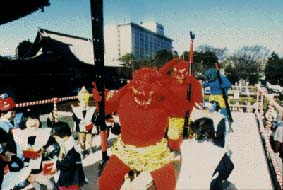ANNUAL CALENDAR February |
|
Setsubun and bean-throwing
|
Japan has four distinct seasons: spring, summer, autumn, and winter. The term setsubun originally referred to the days marking the change from one season to the next, so that there were four of them, but today only the day before risshun (the beginning of spring in the traditional Japanese calendar) is called by that name. Setsubun comes on either February 3 or 4, depending on the year.
 On the night of Setsubun, many households do mame-maki--a bean-throwing ceremony. They fill a masu (a wooden measuring cup) with roasted soybeans and throw the beans all about the room, shouting "Oni wa soto! Fuku wa uchi!" meaning "Out with the goblins and in with fortune!" They also open the windows and throw the beans outside. Mame-maki began as a New Year ceremony (in the traditional Japanese calendar) to drive out evil spirits and the seeds of misfortune, as well as to pray for the family's well-being and good business.
On the night of Setsubun, many households do mame-maki--a bean-throwing ceremony. They fill a masu (a wooden measuring cup) with roasted soybeans and throw the beans all about the room, shouting "Oni wa soto! Fuku wa uchi!" meaning "Out with the goblins and in with fortune!" They also open the windows and throw the beans outside. Mame-maki began as a New Year ceremony (in the traditional Japanese calendar) to drive out evil spirits and the seeds of misfortune, as well as to pray for the family's well-being and good business.
After the mame-maki is over, everyone eats the same number of beans as their own age. It is believed that by doing so, people will be free of sickness during that year. Families with little children especially look forward to this day because mame-maki can be a lot of fun. One person acts as the goblin and runs around, while the others throw beans at the person. At some schools, the students make goblin masks and enjoy mame-maki. Thanks to the great fun of mame-maki, Setsubun is still a popular traditional event.
Photo: Men dressed in goblin costumes chase the children around, while the kids throw beans from their masu. (Ministry of Foreign Affairs) |
APR | MAY | JUN | JUL | AUG | SEP | OCT | NOV | DEC | JAN | FEB | MAR |
 |